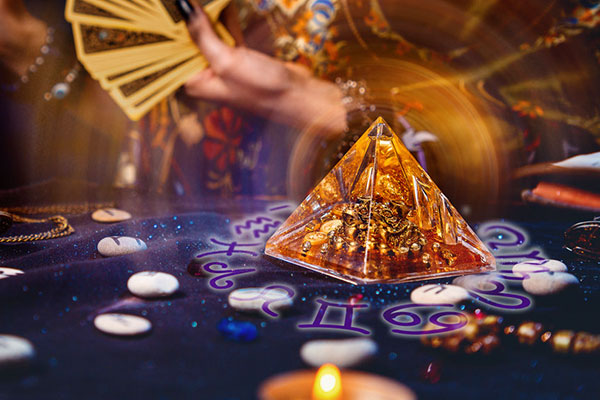psychic advisor
The Power Of Psychic Prediction
 The future is fluid and dynamic, and responds to the forces of the present moment. Feeling peaceful, grounded and centered in the present moment is a feeling we all strive to experience every day, but the challenges of life often pulls in memories of the past, and worries about the future.
The future is fluid and dynamic, and responds to the forces of the present moment. Feeling peaceful, grounded and centered in the present moment is a feeling we all strive to experience every day, but the challenges of life often pulls in memories of the past, and worries about the future.
Thoughts of the future can bring up fear and anxiety as we face the unknown, especially when viewed through current life challenges. In such challenging times you may want to consider reaching out to a psychic advisor, for clarity and support in navigating the path ahead. In my own life I have valued the support of a trusted fellow psychic advisor, especially during emotional and challenging times.
We all experience difficult times, and having someone hold a vision for us about our future path can be highly valuable. Someone to see the divine order in unforeseen events, and show us a way through the uncertainty, despite the challenges and broken pieces of the present. This reassurance helps to strengthen our resolve and belief in ourselves and our future.
As a psychic reader, I have great awareness of the power of a prediction. I believe that the true gift in a prediction is that they can provide a preparedness for the journey ahead, and they can anchor us in faith and hope. Faith is to have trust in something or someone, and it is a source of comfort.
Asking the Divine about the likelihood of future outcomes shows an open-heartedness and desire to see beyond the current. It also says to the Divine, show me the way. Guide me the vision, so that I may walk with more clarity and an open mind and heart.
Life-Changing Success Stories From Psychic Readings
 At Psychic Access, we’ve had the honor of supporting thousands of clients over the past 20 years as they navigate life’s many challenges and transitions. Time and again, we have witnessed how just a single reading can be a powerful turning point in someone’s life.
At Psychic Access, we’ve had the honor of supporting thousands of clients over the past 20 years as they navigate life’s many challenges and transitions. Time and again, we have witnessed how just a single reading can be a powerful turning point in someone’s life.
Our gifted team of psychics and mediums offer clarity when life feels confusing and provide compassionate, nonjudgmental support when people need it most. Whether they contact us during a time of heartbreak, confusion, loss, stress, or simply out of curiosity, our mission is to help them feel more empowered and inspired by the end of every call.
For some, a reading can provide the validation needed to trust their gut or follow their heart. For others, it provides the motivation to take action, or release what no longer serves them. It is also not uncommon for there to be tears of sadness, and of joy.
Many of these breakthrough moments are powerful realignments that reconnect the heart, mind, and soul with the higher self, spirit and the divine. A reading with a skilled psychic illuminates the next step on one’s path.
Though each person’s journey is unique and personal, familiar themes echo in the success stories we witness every day: courage, awakening, healing, forgiveness, renewal, peace, prosperity.
Many of these experiences are simply too good not to share. So, we asked some of our long-time, most loyal clients if we could share some of the feedback and messages we’ve received from them in the hope of inspiring others facing similar challenges. Their names have been redacted, and potentially identifying details have been changed, to protect their privacy.
Soul To Soul Connection In The Digital Age
 In recent years, artificial intelligence (AI) has made significant strides in mimicking human interaction. From chatbots that answer customer service questions to AI-generated horoscopes and tarot spreads, technology is omnipresent, even within the spiritual community.
In recent years, artificial intelligence (AI) has made significant strides in mimicking human interaction. From chatbots that answer customer service questions to AI-generated horoscopes and tarot spreads, technology is omnipresent, even within the spiritual community.
However, there’s a clear distinction between simulated interaction and a genuine spiritual connection. AI can scan data, detect patterns, and even “learn” to mimic language and tone. However, it lacks two essential components: a heart, and a soul.
Technology may be evolving faster than ever before, but some things will always be fundamentally human and spiritually profound. When seeking comfort, clarity, or connection, the presence of another person makes all the difference.
AI is here to stay, and in many areas, it brings undeniable benefits. But when it comes to your spiritual journey, there’s a reason people have turned to seers, mediums, and mystics for centuries. There’s a wisdom that flows only through human heart, mind and soul, a depth of understanding that no algorithm or “for you page” can match.
At PsychicAccess.com, true guidance is more than just data. It’s a dialogue of transpersonal empathy, spiritual insight and divine wisdom. Live readings with our expert psychics or mediums offer something AI can’t replicate: real, soulful exchanges that honor your journey and speak directly to your spirit.
When you choose a live reading with one of our gifted psychics, you’re choosing more than information. You’re choosing personal transformation. You’re stepping into a sacred space where you can be seen, heard, and guided with compassion and truth. Continue reading
A Psychic Reading Brings Order To Chaos
 In a typical lifetime the sun will pass over us twenty-five thousand times. If you were to walk just one mile due west each and every day of your life (if such a journey by land were possible) your life would end at the place it began.
In a typical lifetime the sun will pass over us twenty-five thousand times. If you were to walk just one mile due west each and every day of your life (if such a journey by land were possible) your life would end at the place it began.
Just one mile every day, at a most comfortable stroll, you will have experienced more than anyone, and lived the dreams of most. Instead of merely waiting and watching the sun and time pass by.
If we walk slowly through life, but with purpose, we will see more, travel farther on less energy, and allow others more time to get out of our way. But occasionally, we will meet immovable objects in our path, and a decision on which way to turn must then be made.
Having a precise destiny in mind is challenging in itself, so making the right decisions along the way is essential to ensure our safe arrival at our intended destination.
In my own journey, I remind myself to smile demurely at those skeptical of what I do, even if their cynicism always surprises me, as we all foresee the future all the time.
For example, watching a carefree child at play, unaware in the midst of their joy of the likelihood, the inevitability of a fall sometimes becomes apparent and very clear to those with experience looking on.
The fact that some of us are able to see more, and in more detail, and further into the future, should therefore not be so impossible to conceive – as disconcerting or uncomfortable as this may be to the doubter.
What To Expect From Your First Psychic Reading
 Getting a psychic reading for the first time is exciting, but also a bit intimidating, or even nerve-wracking. You may experience a mix of emotions: intrigue, excitement, nervousness, and even skepticism. That’s all completely normal!
Getting a psychic reading for the first time is exciting, but also a bit intimidating, or even nerve-wracking. You may experience a mix of emotions: intrigue, excitement, nervousness, and even skepticism. That’s all completely normal!
If you’re unsure about what to expect, how to prepare, or which questions to ask, we’ve got your back. At Psychic Access, we understand the range of emotions that accompany your first session.
That’s why we’ve created this guide to help you feel more prepared, empowered, and open to the insights that await you. Your first reading is a deeply personal experience, and we’re here to ensure that it is also empowering, enlightening, and transformative.
The first step to having a powerful reading is knowing why you’re seeking one. What is your goal or intention? Why are you seeking a reading?
Are you seeking clarity about a relationship or your love life? Do you need insight on your career or business, or finances? Do you want spiritual guidance with your path or purpose. Or are you simply curious?
A reading with an expert psychic or medium can be a powerful, life-changing experience. Defining your intention sets the energetic tone of your session and lays the foundation for meaningful guidance.
Take a moment to center yourself and ask, “What do I hope to gain from this reading?” Having a clear purpose allows spirit to align the reading with your highest good.
Upgrade Your Love Life With Psychic Insight
 As joyful and exhilarating as romantic relationships can be, they can at times also be very frustrating and confusing. And in today’s world it’s not getting any easier!
As joyful and exhilarating as romantic relationships can be, they can at times also be very frustrating and confusing. And in today’s world it’s not getting any easier!
Relationship dynamics have become increasingly complex and emotionally charged in a fast-changing social landscape, often leaving many people feeling overwhelmed and uncertain about the future.
While relationships have the power to bring profound happiness, they can also present challenges that lead to anxiety, heartbreak or emotional distress. In times of disappointment or doubt, seeking the guidance of a gifted psychic or medium can provide invaluable insights – offering clarity, reassurance and a renewed sense of direction.
Love and relationship readings have been popular since ancient times, and on platforms like PsychicAccess.com they remain one of the most sought after services – and with good reason.
The enduring popularity of relationship readings reflects humanity’s universal longing for emotional connection, intimacy and fulfilment. Relationships are central to our lives, but these days they are often fraught with significant challenges.
A skilled psychic or medium can offer spirit-guided insights to illuminate hidden truths, deepen understanding and uncover transformative solutions to even the most complicated matters of the heart.
Communication breakdowns, trust issues, or questions about a partner’s intentions are just a few of the typical issues that lead many of our clients to seek the expert advice of our gifted team of psychics.
